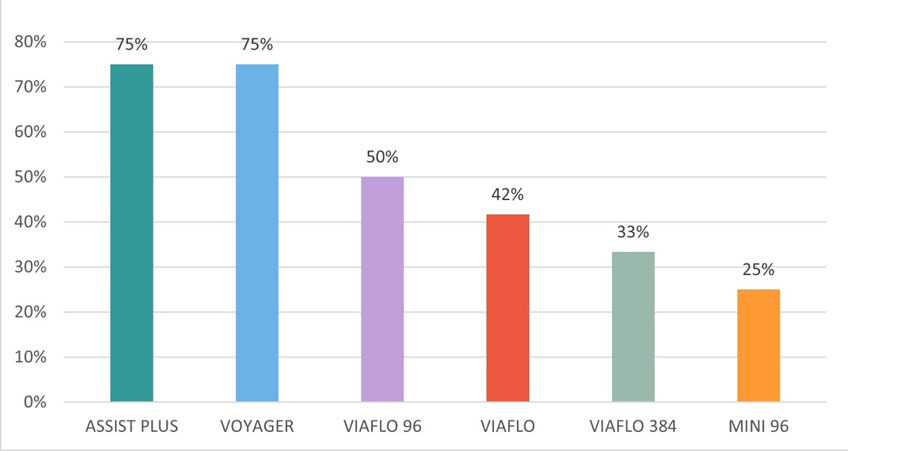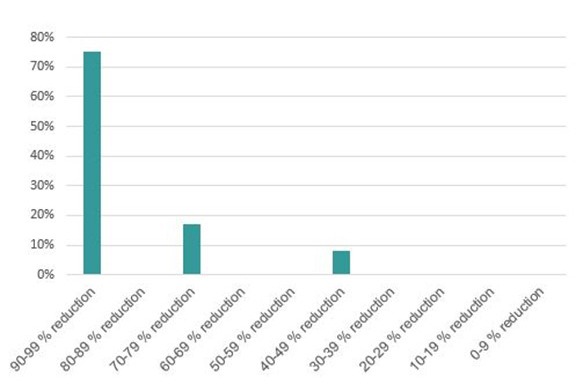Responding to a global health crisis: the evolution of the lab
by Dr Éva Mészáros
Responding to a global health crisis: the evolution of the lab
The COVID-19 pandemic forced life sciences laboratories all over the world to suddenly begin high volume PCR testing, to help gain the upper hand over this deadly disease. Many facilities had to adopt new pipetting platforms at short notice to allow them to automate or streamline their testing workflows and meet the heavy demand. Based on recent survey results, this article looks at the benefits these platforms have brought to labs, and how they are now being used post-COVID-19.
The sudden outbreak of SARS-CoV-2 in 2020 meant that clinical research labs all over the world were suddenly forced to completely change their focus to rapid PCR testing as part of wider efforts to bring the virus under control. Many of these facilities had previously been performing their liquid handling steps entirely manually, but it soon became clear that processing the vast numbers of samples pouring in each day by hand would be impossible. This prompted labs to seek new instrumentation solutions that would allow them to streamline their testing workflows for increased sample throughput and faster turnaround times, despite constant staff absences due to illness and sporadic peaks in case numbers.
PCR testing for SARS-CoV-2 has been gradually scaled back in most countries over recent months, sparking curiosity as to how the liquid handling tools acquired during the pandemic are now being used, if at all. To shed some light on this topic, INTEGRA Biosciences sent out a survey to its customers who had previously been performing COVID-19 testing, asking how they had been using their new platforms and devices since the pressure of the pandemic began to ease off.
Adapting to the need
The labs that participated in the survey came from a broad spectrum of scientific fields – spanning genomics, toxicology, virology and molecular diagnostics – all requiring different liquid handling protocols. The results of the survey showed that half of these facilities were performing all of their liquid handling steps manually prior to the onset of the pandemic, and purchased pipetting platforms and devices from us to allow them to increase their capacity and cope with the high numbers of samples they were receiving every day for PCR testing.
The labs chose a variety of instruments for this purpose according to their specific needs, lab set-up and team size, including the VOYAGER adjustable tip spacing pipettes, VIAFLO 96 and VIAFLO 384 handheld electronic pipettes, VIAFLO lightweight electronic pipettes and MINI 96 portable electronic pipettes (Fig. 1). In addition, 75% of labs chose to transition over to complete automation of liquid handling workflows with an ASSIST PLUS pipetting robot.
Figure 1. Respondents gained a variety of INTEGRA pipetting solutions during the pandemic to handle high sample numbers
Demonstrating versatility
All of the laboratories involved in the survey reported that the demand for COVID-19 testing is now far less than it was during the peak of the pandemic, with 75 % of facilities processing only 10% of the sample volumes they saw at the height of their testing operations (Fig. 2). As the need for testing has decreased, the pipetting instruments acquired specifically to support high volume PCR workflows have gradually become available for use in other applications. This has allowed labs to explore new ways of incorporating their instruments into pre-existing or novel post-COVID-19 processes, enabling them to adapt to meet emerging needs.
Figure 2. The number of samples tested for COVID-19 has dropped dramatically since the peak of the pandemic
For example, ASSIST PLUS owners are responding to the evershifting needs of the healthcare environment by using their pipetting robots to automate high-throughput monkeypox, STI and respira-tory panel assays, as well as for various R&D projects. Over half of the survey respondents said they use their ASSIST PLUS every day, and most labs commented that it was easy to repurpose the pipetting robot for other applications when it was no longer needed for COVID-19 testing.
Our pipettes are also being used to prepare, reformat and transfer samples used in genetics studies – such as nucleic acid extraction and library preparation for next-generation sequencing – as well as for the investigation of mutations in the hemochromatosis, factor V and prothrombin genes. Other labs are currently applying these instruments in antibiotic resistance studies, women’s health testing and biochemical assays. The ability to rapidly evolve in the face of new healthcare needs and research directions demonstrates the versatility of both the liquid handling products and the innovative laboratories using them.
Supporting lab transformation
Why has the ASSIST PLUS remained so crucial to lab workflows in the post-pandemic era? Customers stated that the biggest advantage of automation was the reduction in operator errors that, in turn, leads to greater consistency and accuracy of results. On top of this, they mentioned that automating laborious and time-consuming liquid transfer steps means that fewer staff are needed and that lab throughput is increased. Speaking more generally, users explained that, since our company’s pipetting solutions and accompanying software are so intuitive and straightforward to use, new or less experienced staff members are able to become proficient very quickly. This cut the time needed for training and reduced the associated loss of productivity, further helping labs to maintain a high testing throughput, even when faced with reduced employee numbers during the COVID-19 outbreak.
Many labs are also chronically limited in terms of space, and so it comes as no surprise that survey respondents cited the small footprints of their new devices as being particularly advantageous. This illustrates how these compact pipetting solutions make workflow automation and higher testing throughput more attainable for smaller facilities, which are often short on bench space.
The ASSIST PLUS has allowed laboratories to reduce manual errors for greater result consistency and accuracy, and also increases throughput for enhanced lab productivity.
Investing in future readiness
Based on their positive experiences during the pandemic, 92% of survey respondents plan to use their ASSIST PLUS robots for additional liquid handling applications in the years to come. Two thirds of the participants who were previously aware of the D-ONE single channel pipetting module stated they would find this unit helpful for their upcoming non-COVID projects. When combined with the D-ONE module, the ASSIST PLUS is capable of almost unlimited applications – including tasks such as serial dilutions, sample normalization, hit picking and pipetting of complex plate layouts – illustrating its potential for a wide range of lower throughput protocols as labs evolve once more to serve a post-COVID world.
Conclusion
Looking forward, survey participants suggested numerous types of analyses that are likely to become more prevalent in the near future. These include allergy and infectious disease testing, pharmaco-genomics and targeted genome sequencing – with the human gut microbiome, antimicrobial resistance and even zoonotic diseases highlighted as growing areas of interest for scientists all over the world. Hand in hand with the constantly changing scientific landscape go unpredictable external challenges, such as an erratic supply chain, inflated running costs and widespread understaffing. These difficulties are exacerbated by sporadic outbreaks of infectious diseases, which are becoming ever more frequent and harder to control, due to globalization and the convenience of international travel.
Life sciences laboratories are clearly up against a moving target, highlighting the need to adopt flexible and robust liquid handling solutions that will reduce manual input requirements at every stage of the workflow while enhancing throughput and reproducibility, regardless of research focus. Streamlining and automating pipetting will go a long way towards making up for the lack of manpower in the field, helping labs to keep up with the ever-growing demand for high volume complex testing, as well as improving the overall reliability of results. The findings of this short survey indicate that high quality liquid handling products are valuable assets for any lab serious about staying cost effective and remaining adaptable to the diagnostic needs of the future.
The author
Éva Mészáros PhD
INTEGRA Biosciences, 7205 Zizers, Switzerland
Email: info@integra-biosciences.com
For further information visit INTEGRA Biosciences
(https://www.integra-biosciences.com/united-kingdom/en).






